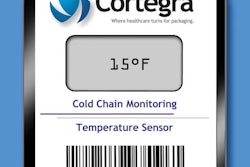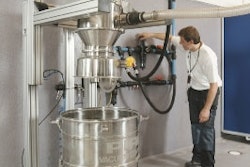Clintrak Clinical Labeling Services, a division of Fisher BioPharma Services, provides clinical trial proofreading services for pharmaceutical/biopharmaceutical manufacturers and contract research organizations that serve pharmaceutical companies. Clintrak checks the accuracy of copy that its customers provide, then approves it for the production of labels, booklets, inserts, reports, and related materials.
Until recently, Clintrak personnel visually proofed copy for its customers, which was a time-consuming process. Now the process is automated, thanks to Docu-Proof text-inspection software employed on four separate computers and two camera verification systems (one is shown below) from Global Vision.
“Prior to the Global Vision solutions, our Document Quality Control group was visually proofreading label proofs on a character-by-character basis to make sure the client-supplied text was transferred to the label proof with100-percent accuracy,” says Chris Hartnagel, account executive for Bohemia, NY-based Clintrak.
“The DQC inspector would place the text and the label proof side-by-side and go back and forth between the two documents and check every character. One of the challenges we faced was the amount of time it took to check 19-panel booklets. This process also put strain on the DQC inspector's eyes and his or her ability to concentrate over a long period of time,” he adds. “Another big challenge was verifying foreign text such as Hebrew and Asian characters.”
He says that proofing copy for a single-panel label would take 20 minutes. A 19-panel booklet would take upward of three hours. Depending on the extent of the label proof being checked, it could involve one or two people to do the job.
Growing labor demand and the time it took to turn around customer jobs led to a change. “Clintrak recognized the need to make the proofreading process quicker in order to shorten client timelines,” Hartnagel notes. “Clintrak wanted to be able to pass the benefits of quicker proofreading techniques all the way through to the clients by making the proofing process easier.”
Reaping the benefits
It didn't take long for Clintrak to begin noticing the benefits of the Global Vision systems, as the DQC inspectors were able to focus their attention more on formatting the labels (page numbers, sentence breaks, etc.), instead of the character-for-character approach they had been taking. And then there's the labor factor.
“The Global Vision solutions allowed the proofreading time for a 19-panel booklet to decrease from three to seven hours to about an hour-and-a-quarter,” Hartnagel explains. “And it helped catch differences in Hebrew text due to different fonts on different documents that could have potentially caused Clintrak to have to redo booklets. The systems have also caught spacing differences on small labels where the text was in a small, five-point font size that the human eye might not have been able to see.
“Beyond that, Clintrak employees have used the Global Vision customer support center for technical questions, supporting client-specific requirements, and any necessary updates. The representatives are always willing to help with any problem and go the extra mile to make sure Clintrak has what it needs.”
Says Reuben Malz, president of Global Vision, “More and more, clinical trial service providers are dealing with multilingual labels with many foreign characters that are extremely difficult to inspect.” “Docu-Proof allows them to achieve complete accuracy without having to understand the text on the label.”
How systems work
Docu-Proof is a text comparator that can detect all changes in documents regardless of their layout or format. It examines both files on a character-by-character basis and extracts any differences it finds between the two, inserting them in a report that Clintrak can use to review. The report details discrepancies in font type, font size, text, spelling, and location changes.
Each TVS-Proofreader camera verification system inspects both hard copy and electronic files. It identifies missing text and graphics, incorrect fonts, text size, bar codes, and broken type, as well as color deviations in labels, inserts, and cartons. It compares a printed sample to a master file. The TVS-Proofreader takes a photo of a production sample and compares it against the master file to ensure uniformity before a batch is printed.
Clintrak generates proofs of label, insert, and booklet copy by computer, creating an Adobe Portable Document File/Format for customers to review. Copy goes back and forth between Clintrak and the customer until the customer approves the copy. Global Vision's Docu-Proof software checks copy not only for typographical errors, but also to confirm patient numbers and develop mixed reports.
Hartnagel says, “The mixed reports that we generate connect valuable information such as randomized numbers, lot numbers, and expiry dates that link to each trial group and to the appropriate matching label. That's a links report. These are used for all label types, whether it is a single-panel label that goes directly on a container, a two-panel label with a perforation in-between so you can tear one, put it on the container, and use the other one on the case report form, or for multilingual booklet labels.
“Camera verification systems take a photo of a proof in order to compare that image with the image of another proof or label. The system then overlays the two images and shows us the differences in the copy.”
When asked about the potential problems that could come up from errors that might make it to the clinical trial packaging materials, Hartnagel explains, “It could be a number of things. First, time is always money, and there are costs with having to rework labels.
“If you check something by eye and miss a character in a foreign language, it could completely change the meaning of the statement. And if that occurs, we have to scrap all those labels and remanufacture them. That's costly and labor-intensive, and it could mean we miss the clients' packaging dates, and in turn, they are not the first to market.”
With the Global Vision systems, he says, Clintrak was able to shorten client lead times. “We pass along the shortened proofreading times to customers and produce electronic proofs for them,” he says.
Hartnagel explains that the volumes of these clinical trial proofs can range from less than 100 labels per run to upwards of 300,000 labels.
“We use the camera verification systems to conduct sampling at the beginning, middle, and end of runs, where we will pull the booklets or labels, put them under the camera and match those against an approved proof to make sure that everything is in its place,” he says.
He explains that customers send Clintrak text from which Clintrak creates a PDF for the customer to approve. “At that point, we can print the copy,” he says. Hartnagel adds that the Global Vision systems did not require any new equipment for Clintrak.
Hartnagel says that the Global Vision systems allow Clintrak to turn around
jobs in 25 to 30 days from the time it receives information to the time it ships labels. All of the benefits provide proof-positive justification for investing in the text-inspection software and camera verification systems.
Until recently, Clintrak personnel visually proofed copy for its customers, which was a time-consuming process. Now the process is automated, thanks to Docu-Proof text-inspection software employed on four separate computers and two camera verification systems (one is shown below) from Global Vision.
“Prior to the Global Vision solutions, our Document Quality Control group was visually proofreading label proofs on a character-by-character basis to make sure the client-supplied text was transferred to the label proof with100-percent accuracy,” says Chris Hartnagel, account executive for Bohemia, NY-based Clintrak.
“The DQC inspector would place the text and the label proof side-by-side and go back and forth between the two documents and check every character. One of the challenges we faced was the amount of time it took to check 19-panel booklets. This process also put strain on the DQC inspector's eyes and his or her ability to concentrate over a long period of time,” he adds. “Another big challenge was verifying foreign text such as Hebrew and Asian characters.”
He says that proofing copy for a single-panel label would take 20 minutes. A 19-panel booklet would take upward of three hours. Depending on the extent of the label proof being checked, it could involve one or two people to do the job.
Growing labor demand and the time it took to turn around customer jobs led to a change. “Clintrak recognized the need to make the proofreading process quicker in order to shorten client timelines,” Hartnagel notes. “Clintrak wanted to be able to pass the benefits of quicker proofreading techniques all the way through to the clients by making the proofing process easier.”
Reaping the benefits
It didn't take long for Clintrak to begin noticing the benefits of the Global Vision systems, as the DQC inspectors were able to focus their attention more on formatting the labels (page numbers, sentence breaks, etc.), instead of the character-for-character approach they had been taking. And then there's the labor factor.
“The Global Vision solutions allowed the proofreading time for a 19-panel booklet to decrease from three to seven hours to about an hour-and-a-quarter,” Hartnagel explains. “And it helped catch differences in Hebrew text due to different fonts on different documents that could have potentially caused Clintrak to have to redo booklets. The systems have also caught spacing differences on small labels where the text was in a small, five-point font size that the human eye might not have been able to see.
“Beyond that, Clintrak employees have used the Global Vision customer support center for technical questions, supporting client-specific requirements, and any necessary updates. The representatives are always willing to help with any problem and go the extra mile to make sure Clintrak has what it needs.”
Says Reuben Malz, president of Global Vision, “More and more, clinical trial service providers are dealing with multilingual labels with many foreign characters that are extremely difficult to inspect.” “Docu-Proof allows them to achieve complete accuracy without having to understand the text on the label.”
How systems work
Docu-Proof is a text comparator that can detect all changes in documents regardless of their layout or format. It examines both files on a character-by-character basis and extracts any differences it finds between the two, inserting them in a report that Clintrak can use to review. The report details discrepancies in font type, font size, text, spelling, and location changes.
Each TVS-Proofreader camera verification system inspects both hard copy and electronic files. It identifies missing text and graphics, incorrect fonts, text size, bar codes, and broken type, as well as color deviations in labels, inserts, and cartons. It compares a printed sample to a master file. The TVS-Proofreader takes a photo of a production sample and compares it against the master file to ensure uniformity before a batch is printed.
Clintrak generates proofs of label, insert, and booklet copy by computer, creating an Adobe Portable Document File/Format for customers to review. Copy goes back and forth between Clintrak and the customer until the customer approves the copy. Global Vision's Docu-Proof software checks copy not only for typographical errors, but also to confirm patient numbers and develop mixed reports.
Hartnagel says, “The mixed reports that we generate connect valuable information such as randomized numbers, lot numbers, and expiry dates that link to each trial group and to the appropriate matching label. That's a links report. These are used for all label types, whether it is a single-panel label that goes directly on a container, a two-panel label with a perforation in-between so you can tear one, put it on the container, and use the other one on the case report form, or for multilingual booklet labels.
“Camera verification systems take a photo of a proof in order to compare that image with the image of another proof or label. The system then overlays the two images and shows us the differences in the copy.”
When asked about the potential problems that could come up from errors that might make it to the clinical trial packaging materials, Hartnagel explains, “It could be a number of things. First, time is always money, and there are costs with having to rework labels.
“If you check something by eye and miss a character in a foreign language, it could completely change the meaning of the statement. And if that occurs, we have to scrap all those labels and remanufacture them. That's costly and labor-intensive, and it could mean we miss the clients' packaging dates, and in turn, they are not the first to market.”
With the Global Vision systems, he says, Clintrak was able to shorten client lead times. “We pass along the shortened proofreading times to customers and produce electronic proofs for them,” he says.
Hartnagel explains that the volumes of these clinical trial proofs can range from less than 100 labels per run to upwards of 300,000 labels.
“We use the camera verification systems to conduct sampling at the beginning, middle, and end of runs, where we will pull the booklets or labels, put them under the camera and match those against an approved proof to make sure that everything is in its place,” he says.
He explains that customers send Clintrak text from which Clintrak creates a PDF for the customer to approve. “At that point, we can print the copy,” he says. Hartnagel adds that the Global Vision systems did not require any new equipment for Clintrak.
Hartnagel says that the Global Vision systems allow Clintrak to turn around
jobs in 25 to 30 days from the time it receives information to the time it ships labels. All of the benefits provide proof-positive justification for investing in the text-inspection software and camera verification systems.





















